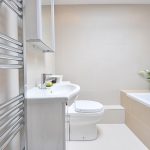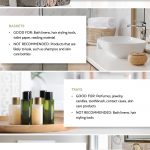Getting Started with Essential Supplies
Before diving into bathroom cleaning, you’ll need the right tools and products. Having everything ready makes the job easier and faster.
Choosing the Right Cleaning Products
Pick cleaning products that work well for your bathroom surfaces. An all-purpose cleaner is great for most areas. Get a toilet bowl cleaner for tough stains. Disinfectant sprays kill germs on high-touch spots. White vinegar mixed with water in a spray bottle cleans mirrors and faucets.
For scrubbing, grab a sponge and some paper towels. Don’t forget rubber gloves to protect your hands. If you have hard water stains, you might need a special cleaner for those.
Read product labels to make sure they’re safe for your surfaces. Avoid mixing different cleaners, as this can be dangerous.
Preparing Your Cleaning Caddy
A cleaning caddy keeps all your supplies in one place. Choose a caddy with a handle for easy carrying. Put your cleaning products, sponges, and paper towels inside.
Add some microfiber cloths – they’re great for dusting and wiping. Include an old toothbrush for cleaning tight spots. Don’t forget your rubber gloves.
Keep a few trash bags in your caddy for easy cleanup. A small squeegee can help with mirrors and shower doors. If you use DIY cleaners, add empty spray bottles to your kit.
Having a well-stocked caddy means you won’t have to stop mid-clean to find supplies. This saves time and makes cleaning less of a chore.
Dusting and Decluttering
Keeping your bathroom dust-free and organized makes cleaning easier and creates a fresh, tidy space. A clean bathroom starts with removing dust and putting everything in its place.
Removing Dust and Cobwebs
Grab a microfiber cloth or duster to tackle dust buildup. Start at the ceiling and work your way down. Wipe light fixtures, vents, and fan blades. Don’t forget window sills and baseboards.
For hard-to-reach spots, use an extendable duster. Pay attention to corners where cobwebs like to hide. Dust picture frames and mirrors too.
Wipe down countertops and shelves. Use a damp cloth for stuck-on dust. Clean small items like soap dishes and toothbrush holders.
Tidying Up and Organizing
Clear off countertops and put away items you don’t use daily. Sort through cabinets and drawers. Get rid of old makeup, expired medicines, and empty bottles.
Use organizers to keep things tidy. Try drawer dividers for makeup and hair tools. Add small baskets to cabinets for extra toilet paper and cleaning supplies.
Hang a shower caddy to keep shampoo and soap off the tub edges. Put out-of-season items in labeled boxes under the sink. A clutter-free bathroom is easier to clean and more relaxing to use.
Deep Cleaning the Toilet
A sparkling clean toilet is key to a fresh bathroom. Regular deep cleaning removes tough stains and kills germs on all surfaces.
Toilet Bowl Stain Removal
Start by putting on gloves. Squirt toilet bowl cleaner around the inside of the bowl. Let it sit for 10 minutes. This gives the cleaner time to break down stains.
Scrub the bowl with a toilet brush, paying extra attention to the rim and under it. Don’t forget the water outlets. For stubborn marks, use a pumice stone.
Flush to rinse. For mineral buildup, pour 1 cup of white vinegar in the bowl and let sit overnight. Scrub and flush in the morning.
Disinfecting Frequently Touched Surfaces
Wipe down the entire outside of the toilet with disinfecting wipes or a sponge and cleaner. Focus on the seat, lid, and handle. These areas collect the most germs.
Clean the base of the toilet where it meets the floor. Dust and grime can build up here. Use a damp cloth to get into tight spots.
Don’t forget the tank lid and flush buttons. Spray with cleaner and wipe dry. For a deeper clean, remove the tank lid and wipe inside too.
Scrubbing and Sanitizing Showers and Tubs
Keeping your shower and tub clean is key for a fresh bathroom. Regular scrubbing prevents buildup and makes deep cleaning easier.
Grime and Mildew Growth Handling
Start by spraying the shower or tub with a mixture of equal parts white vinegar and warm water. Let it sit for 10-15 minutes. This helps loosen grime and kill mildew.
Next, sprinkle baking soda on a damp cloth or sponge. Scrub all surfaces, paying extra attention to corners and crevices. For tough spots, use an old toothbrush.
Rinse everything thoroughly with warm water. To prevent future mildew, keep the area dry. Use a squeegee on walls after showering. Open a window or run the fan to reduce moisture.
For stubborn mold, mix 1 part bleach with 10 parts water. Apply with a sponge, let sit for 10 minutes, then rinse well.
Dealing with Shower Doors and Curtains
For glass doors, use the vinegar spray method mentioned earlier. Wipe with a microfiber cloth to avoid streaks. For soap scum, make a paste with baking soda and water. Apply, let sit, then scrub off.
Plastic shower curtains can go in the washing machine. Add a few towels for extra scrubbing action. Use warm water and a small amount of detergent. Hang to dry completely before rehanging.
For fabric curtains, check the care label. Most can be machine washed on a gentle cycle. Add 1/2 cup of baking soda to the wash for extra freshness.
To prevent mildew on curtains, spread them out after each use. This allows them to dry faster.
Making Mirrors and Glass Sparkle
Clean mirrors and glass surfaces make your bathroom shine. With the right tools and methods, you can get a streak-free finish easily.
Streak-Free Techniques
Mix equal parts water and white vinegar in a spray bottle for a simple glass cleaner. Spray it on a microfiber cloth, not directly on the mirror. Wipe in a zigzag pattern from top to bottom.
For tough spots like toothpaste, dab rubbing alcohol on a cotton pad. Gently rub the stain before cleaning the whole mirror.
Use a squeegee after wiping to remove any leftover moisture. Start at the top and pull down in straight lines, wiping the blade after each stroke.
For a deep clean, add a drop of dish soap to your vinegar solution. This cuts through buildup from hairspray or other products.
Always finish by buffing with a dry microfiber cloth. This picks up any remaining streaks or lint.
Floors First: Vacuuming to Mopping
Clean bathroom floors need good vacuuming and mopping. Start by removing dirt, then use the right cleaning mix to make your floors shine.
Effective Vacuuming Strategies
Start with a thorough vacuum of your bathroom floor. Move rugs and mats out of the way first. Use the vacuum’s attachments to get into corners and along baseboards.
Pay extra attention to areas that collect hair and dust, like behind the toilet. For tile floors, a brush attachment works well to loosen stuck-on dirt.
Don’t forget to vacuum bath mats and washable rugs too. Shake them outside first to remove loose debris.
Mopping with the Right Solutions
After vacuuming, it’s time to mop. Fill your sink with 2 gallons of warm water, 1/4 cup vinegar, and a squirt of dish soap. This mix cleans well and is safe for most floors.
Dip your microfiber mop in the solution and wring it out. Start in the farthest corner and work backwards to avoid stepping on clean areas. Use overlapping strokes to cover the whole floor.
For tough spots, let the cleaner sit for a minute before scrubbing. Rinse your mop often in clean water. Go over the floor one last time with just water to remove any leftover soap.
Let the floor air dry or use a clean towel to speed things up. Your bathroom floor should now be fresh and clean!





